This guide provides a comprehensive understanding of the lumen requirements for your soccer or football field. Given that lighting needs can vary between different fields, each section details the specific lumen levels required for optimal illumination. Additionally, the guide covers factors that can affect lumen output, such as light reflection angles and the importance of pole placement. Beyond serving the players, field lighting is also crucial for television broadcasts and spectator experience.
Table of Contents
ToggleFactors Affecting the Lumens Required for Lighting a Soccer Field
Soccer Field Size
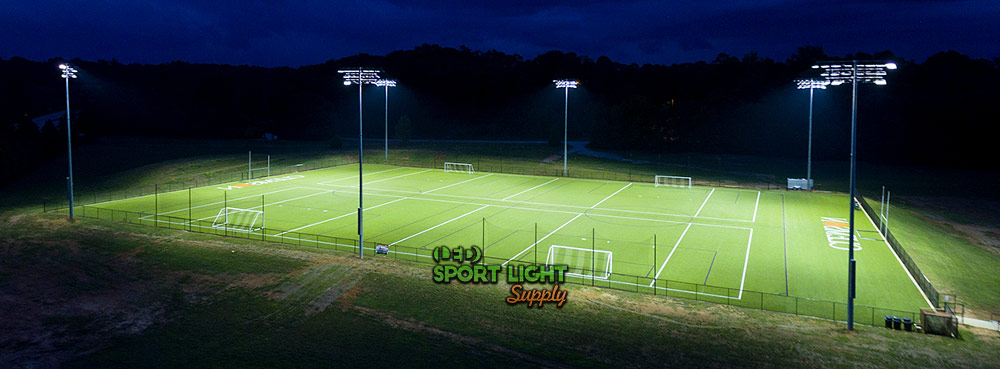
The size of a soccer field significantly impacts the lumens required for proper lighting. Not all soccer or football pitches are the same dimensions, and larger fields generally require more lumens to ensure uniform illumination. The design of the field, whether it is an arena or stadium, plays a crucial role in determining the lighting layout. A larger field may present challenges such as uneven lighting, necessitating more lumens to achieve optimal coverage. By designing a suitable lighting scheme, you can enhance visibility and ensure that players benefit from adequate lighting across the entire field.
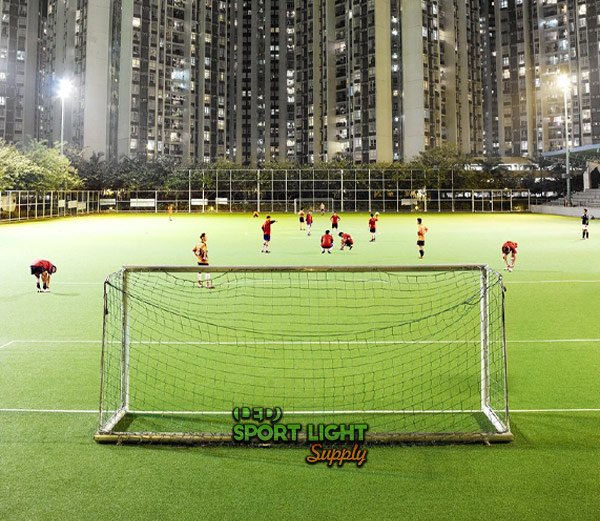
Level of Competition
The lighting requirements vary based on the level of competition. There are three primary competition levels:
| Competition Level | Description |
|---|---|
| Class I | Professional soccer leagues |
| Class II | Semi-professional and college-level soccer |
| Class III | High school soccer |
Each competition level has specific lighting standards to meet the needs of the players and viewers. Class I fields typically require higher lumen output to accommodate larger audiences and television broadcasts. In contrast, lower competition levels may have less stringent lighting needs. The brightness and uniformity of the lighting are crucial for creating a suitable environment for both players and spectators.
Number of Light Poles
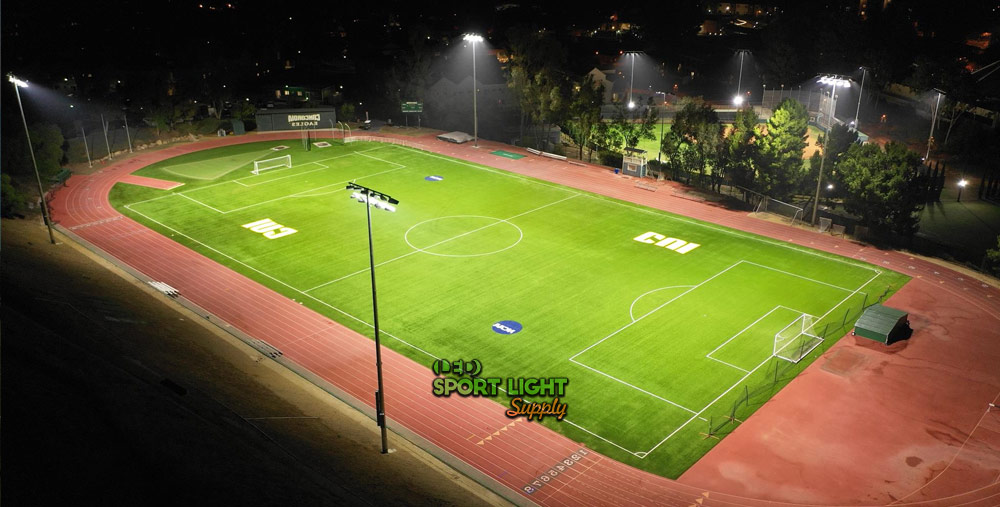
The number of light poles affects both the illumination quality and the level of play. For smaller high school fields, four poles may suffice, though six poles can be used if additional lighting is necessary. Professional fields generally feature between six and eight poles, with the possibility of additional fill lights. Placing poles at each corner of the field is standard, but adding poles along the centerline can enhance uniformity and strength of the light coverage. As field size increases, so does the need for additional poles and corresponding lumens.
Light Pole Height
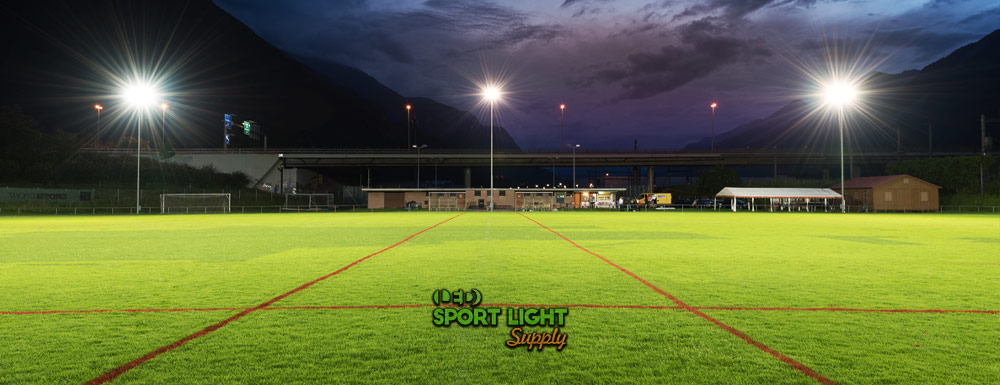
The height of the light poles is a critical factor in field lighting. For large fields within stadiums, tall pole masts with powerful lights are essential. The distance between the field and the light source affects the amount of lumens required due to a phenomenon known as attenuation. The greater the distance, the more powerful the light must be to maintain effective illumination. Proper adjustment of lumen output is necessary based on the height of the poles and the distance from the field.
Soccer Field Light Pole Layout
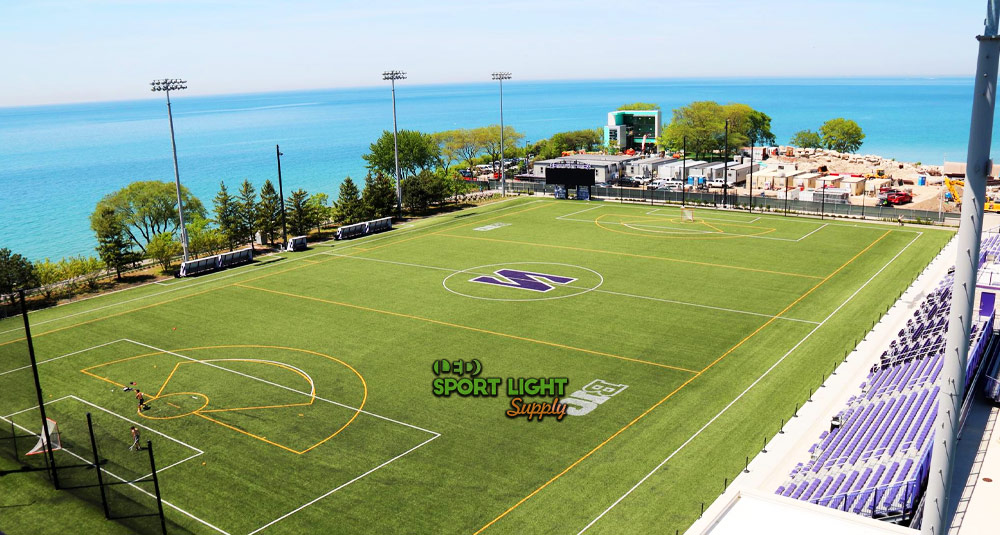
The layout of light poles is influenced by the design of the field and the presence of spectator seating. For fields with platform seating, such as stadiums and arenas, lighting must accommodate the positioning of bleachers and stands. Lights placed at the corners of the field are typical, with additional side pole lights if necessary. For fields without surrounding structures, centerline lights may be positioned differently, often behind the back rows of bleachers.
Beam Angle of Soccer Lights
Directing floodlights at the correct angle can be challenging, leading to issues such as light leakage and glare. Poorly designed reflectors may cause light to scatter, resulting in a loss of lumens. To mitigate these issues, adding light shields can help reduce light flare and glare, enhancing overall visibility. Modern LED lights have improved directional control, reducing light leakage and providing better performance in terms of beam angle.
How Many Lumens Does It Take to Light a Standard Soccer or Football Field?
Training or Recreation
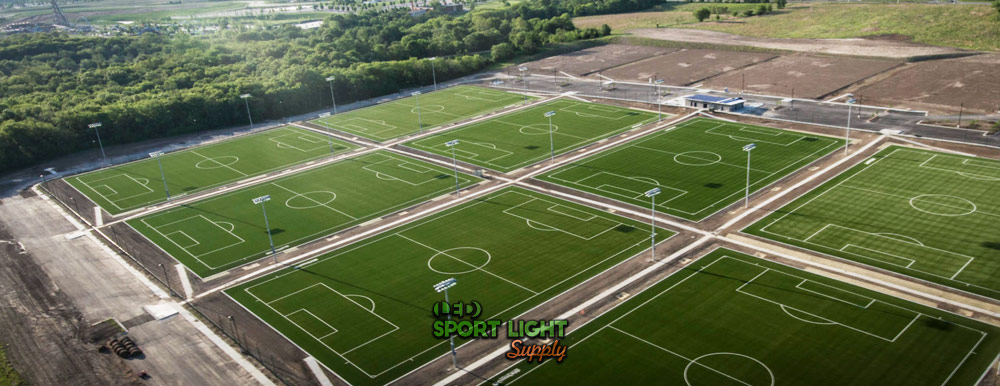
For training sessions and recreational play, soccer field lighting does not need to be overly intense. The goal is to provide enough illumination for players to see the field and each other clearly. Typically, this level of lighting is found in public parks and high schools. It’s usually sufficient to have a lighting level of 200-300 Lux, which ensures safety and visibility without being overwhelming. This amount of light is comfortable for practice sessions, even for semi-professional players, and helps reduce the risk of injuries.
Lux to Lumen Conversion
To understand how this translates into lumens, consider the following example. For a soccer field with 200 Lux and an area of 10,625 square meters, you would need approximately 2,125,000 lumens. To account for light loss through pole lighting, an adjustment is necessary. For instance, multiplying the initial lumen amount by factors of 1.1 or 1.2 results in 2,337,500 or 2,550,000 lumens, respectively. If the poles are particularly tall, the required lumens might increase further, up to 2,762,500 lumens for a 1.3 adjustment. This adjusted lumen requirement ensures adequate illumination across the field, with each pole distributing a portion of the total lumens.
Regional Competition, High School
As the level of competition increases, such as in high school and local regional games, the lighting needs become more demanding. While still less intense than professional standards, regional competition fields require lighting levels of 500 to 700 Lux. This equates to approximately 5,300,000 to 7,500,000 lumens. This level of illumination is suitable for local television broadcasts and provides a vibrant atmosphere for spectators, enhancing the overall game experience.
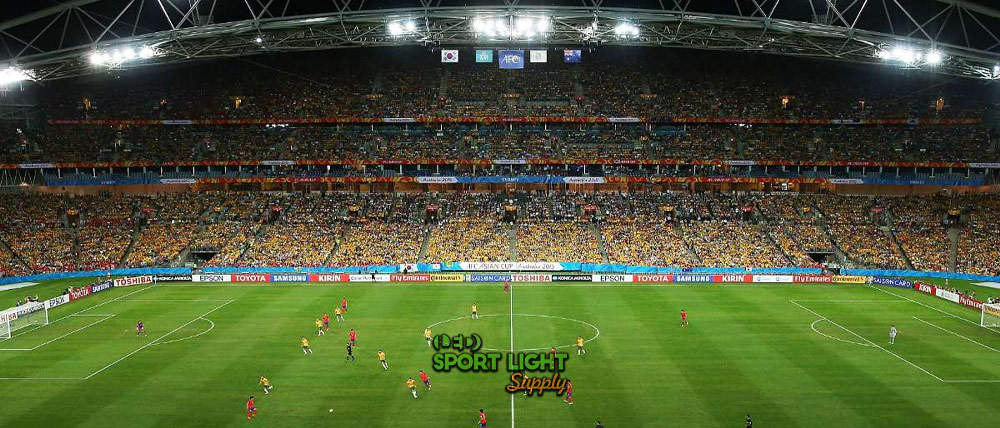
National or International Competitions
At the national or international level, lighting standards become more rigorous. The lighting for these events is designed to create a highly energetic environment for both players and fans. Stadiums at this level typically have lighting setups that meet standards ranging from 750 to 1,000 Lux, equivalent to 8,000,000 to 10,600,000 lumens. The lighting is carefully calibrated to ensure uniformity and clarity, with precise measurements taken across the field to achieve optimal performance. The color temperature is also adjusted to be whiter, mimicking daylight, to enhance visibility and broadcast quality.
FIFA World Cup Standard and Broadcasting
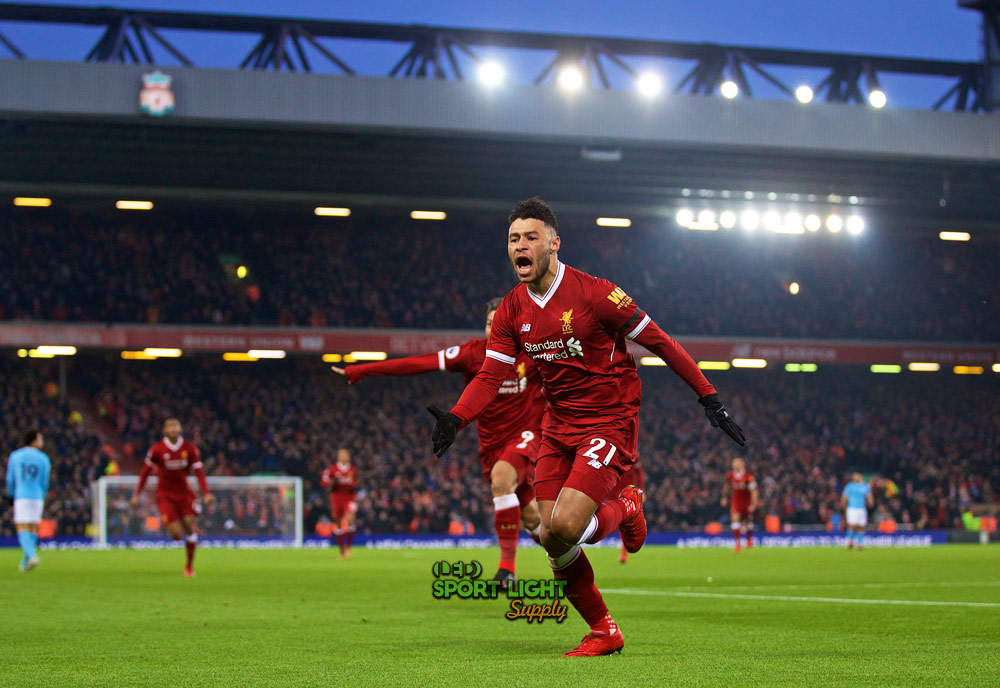
When a soccer match is broadcasted globally, the lighting must meet the highest standards. This level of illumination is evident in the grand stadiums where FIFA World Cup and Premier League matches are held. Thousands of spectators fill these colossal venues to watch the game from every conceivable angle, necessitating lighting that provides 1500 to 2500 lux. To achieve this, approximately 16,000,000 to 26,500,000 lumens are required to adequately light the field.
This intense lighting is crucial for slow-motion cameras that capture and replay every action with exceptional clarity, allowing officials to make accurate decisions. Additionally, the high level of illumination energizes both players and spectators, contributing to the vibrant atmosphere of championship games.
How Much LED Wattage Is Required to Illuminate a Soccer Field?
For the FIFA World Cup and other major international tournaments, the lighting reaches its peak intensity. This level of illumination is required to accommodate thousands of spectators and ensure high-quality broadcasts. Fields are lit to 1,500 to 2,500 Lux, which translates to approximately 16,000,000 to 26,500,000 lumens. Such lighting allows for exceptional clarity in slow-motion replays and provides a high-energy atmosphere that contributes to the excitement of the game. The intense lighting supports detailed camera work and enhances the overall viewing experience for global audiences.
Each LED light operates at a specific wattage, which determines the level of lumens it emits. Another formula allows for a simple conversion to determine the wattage based on lumens. This is always 150 lumens per watt, so for 2,125,000 lumens, the required wattage is 14,200 watts. However, this calculation uses the base formula and does not account for light loss.
Using our adjusted numbers, you would need 15,583 watts for a 1.1 adjustment factor and 17,000 watts for a 1.2 adjustment factor. If the high pole lights are used in large stadiums, you must consider their extreme height, which requires an adjustment of 18,416 watts at a 1.3 factor for light loss. This calculation tells you the exact wattage needed to be distributed among the light poles. With the number of lumens and wattage determined, the remaining task is to decide the number of lights per pole.
These calculations are then carried out by a sports lighting expert, and you can proceed to purchase your lights accordingly. It’s always best to pre-calculate the amount of light loss to ensure your field maintains the required lumen or lux levels. Since each class is already determined, adjusting for lux to lumens and lumens to watts becomes more straightforward.
| Lumens Required | Base Wattage Calculation | Adjustment Factor | Adjusted Wattage |
|---|---|---|---|
| 2,125,000 lumens | 14,200 watts (150 lumens/watt) | 1.1 | 15,583 watts |
| 2,125,000 lumens | 14,200 watts (150 lumens/watt) | 1.2 | 17,000 watts |
| 2,125,000 lumens | 14,200 watts (150 lumens/watt) | 1.3 | 18,416 watts
|
The Importance of Using the Right Amount of Lumens for Soccer Field Lighting
Preventing Energy Waste
One of the most common errors in installing soccer field lighting is neglecting proper calculations. Excessive lumens can lead to overly bright fields, which not only result in wasted energy but also create an unbalanced lighting effect. This can cause glare and wash out important details, making the experience less enjoyable for players and spectators. By adhering to accurate lighting calculations, you can ensure efficient energy use while achieving optimal brightness without unnecessary excess.
Enhancing the Experience for Players and Fans
Properly calibrated lighting contributes significantly to the overall atmosphere of the soccer field. Lighting levels should be tailored to the specific needs of the field and the intensity of the game. Over the past 50 years, soccer field lighting has evolved into a precise science, reflecting advancements in lighting technology and a deeper understanding of its effects on the game. Correctly specified lumens enhance visibility and create a more engaging environment for both athletes and spectators, aligning with the expectations of modern sports events.
Improving Photography and Broadcast Quality
The advent of digital cameras has raised the bar for capturing high-quality sports footage. Modern LED lighting enables the capture of fine details, which is crucial for slow-motion replays and in-depth analysis. Using the appropriate amount of lumens ensures that high-end cameras can record crisp, clear images, enhancing the quality of broadcasts and providing valuable insights for training. Well-calibrated lighting allows viewers to experience the game in high definition, showcasing athletic performance with exceptional clarity.
Issues with Inadequate Soccer Field Lumens
Dim Lighting on the Soccer Field
Inadequate illumination on a soccer field often stems from improper lumen calculations or light loss due to poorly angled fixtures. Using lights with the incorrect Lux levels can result in insufficient brightness, making the field appear too dim for both players and spectators. Ensuring accurate lumen calculations and proper light placement is crucial for achieving optimal visibility and enhancing the overall experience.
Excessive Light Flare
Choosing inappropriate lighting fixtures for soccer fields can lead to excessive light flare, which can be distracting and uncomfortable for both players and spectators. Fixtures not designed for sports lighting may cause unwanted glare. Non-LED floodlights, which often cover wider areas, can exacerbate flare issues compared to LED lights, which are more directional and help create a more uniform lighting effect. Properly selected LED floodlights minimize flare and improve the overall quality of field lighting.
Lack of Light Loss Adjustment
Failing to account for light loss during the design and installation of field lighting can result in under-illuminated areas. To ensure consistent brightness, it’s essential to incorporate a buffer of additional lumen coverage. This adjustment compensates for any natural or unanticipated light loss, ensuring the soccer field remains adequately illuminated throughout its use.
Conclusion
Consulting with sports lighting experts can help you determine the best lighting solutions for your soccer field. Following precise calculations and incorporating appropriate adjustments will ensure your field maintains the correct level of illumination. This approach prevents issues related to dim lighting, flare, and light loss, ensuring a well-lit environment for both play and viewing.
